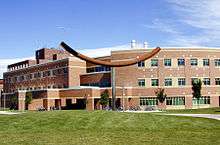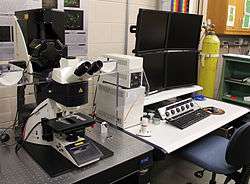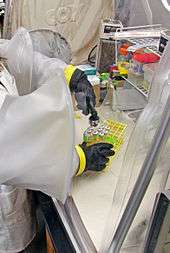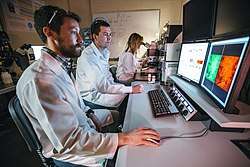Center for Biofilm Engineering
The Center for Biofilm Engineering (CBE) is an interdisciplinary research, education, and technology transfer institution located on the central campus of Montana State University in Bozeman, Montana. The center was founded in April 1990 as the Center for Interfacial Microbial Process Engineering with a grant from the Engineering Research Centers (ERC) program of the National Science Foundation (NSF).[3] The CBE integrates faculty from multiple university departments to lead multidisciplinary research teams—including graduate and undergraduate students—to advance fundamental biofilm knowledge, develop beneficial uses for microbial biofilms, and find solutions to industrially relevant biofilm problems. The center tackles biofilm issues including chronic wounds, bioremediation, and microbial corrosion through cross-disciplinary research and education among engineers, microbiologists and industry.[4][5]
 Montana State University’s Barnard Hall, home of Center for Biofilm Engineering | |
| Parent institution | Montana State University |
|---|---|
| Established | April 15, 1990[1] |
| Mission | Advance the basic knowledge, technology and education required to understand, control and exploit biofilm processes |
| Director | Matthew W. Fields (2015–current) Philip S. Stewart (2005–2015) John W. Costerton (1993–2004) William G. Characklis (1990–92) |
| Formerly called | Center for Interfacial Microbial Process Engineering[2] |
| Location | Bozeman , Montana , United States |
| Coordinates | 45°39′57″N 111°02′47″W |
| Website | www |
History
The center originated as the Institute for Chemical and Biological Process Analysis (IPA) in 1983.[1] In 1990, the center became a national ERC as the Center for Interfacial Microbial Process Engineering based on a $7.2 million grant from the NSF.[2] In 1993 the center assumed its current name-Center for Biofilm Engineering. The original grants expired in 2001 and the center became self-sufficient. The center is celebrating its 30th anniversary as an NSF ERC throughout 2020.
Institute for Chemical and Biological Process Analysis (1979–1990)
In 1979 W.G. (Bill) Characklis came to Montana State University from Rice University as a professor in civil (environmental) and chemical engineering. He assembled a multidisciplinary team of engineers, microbiologists and chemists to study the processes and effects of microbial growth at interfaces[6] He established a cross-disciplinary environmental biotechnology institute to address the needs of industry in the areas of biofouling, microbial corrosion and biofilm technology.[1] The Institute for Chemical and Biological Process Analysis (IPA) was chartered by the Montana Board of Regents in 1983 within the Montana State University College of Engineering. Bill Characklis was its first director. The IPA provided the foundation for eventual Engineering Research Center status in several ways. The IPA conducted fundamental research, development, and testing for industry and government agencies and it pursued biofilm projects that crossed traditional scientific discipline boundaries.[7] The IPA established an Industrial Associates membership program and by 1989 the program had 12 participating members, each contributing $10,000 annually to the center. Membership benefits provided them the opportunity to assist in critiquing and defining the IPA research programs. Members included oil/gas/power companies, a chemical manufacturer, a pulp and paper company and partnership with the Idaho National Engineering Laboratory.[8]
Center for Interfacial Microbial Process Engineering (1990–1993)

In 1989, the IPA applied to the NSF for Engineering Research Center status, which was granted in April 1990.[3] The Center for Interfacial Microbial Process Engineering was established as one of three national Engineering Research Centers out of 48 applicants.[9] As an ERC, the new organization was charged with building a cross-disciplinary research and education program at Montana State University, as well as increasing U.S. industrial competitiveness in biofilm related technologies. The center's charter mandated that research, education, and technology transfer programs would be fully integrated within the center's program planning. The Industrial Associates program continued to be used as a mechanism for the center to get information from industry about significant biofilm-related problems and collaborate on center research initiatives designed to address biofilm issues. The center's education program recruited students to participate on interdisciplinary research teams and to interact with industry representatives.[1]
The provision of $7.2 million in grants from the NSF during the first five years enabled the expansion of center research into new areas, notably bioremediation and biohydrometallurgy. The center's industrial focus expanded from biofilm control and mitigation to include positive use of biofilm processes to break up soil and water contaminants as well as extracting minerals from low-grade ores.[1] Center projects were designed to span scales of inquiry from fundamental bench-scale to applied field-scale experiments. These projects enabled the continued development of microsensors to measure gradients of gases and pH within biofilm communities,[10] microscopy to elucidate physiological activity of community organisms[11] and modeling to predict biofilm behavior.[12]
Center for Biofilm Engineering (1993–present)
In 1992, two years after its establishment, the center's first director, Bill Characklis, died. Montana State University signaled its commitment to the center by hiring J.W. (Bill) Costerton, a professor of microbiology from the University of Calgary, as Executive Director and James Bryers, a professor of biochemical engineering from Duke University, as Director of Research for the center. In 1993 the center's name was changed to Center for Biofilm Engineering (CBE).[13]
Under Costerton's direction the center continued to fulfill its charter and began expanding its scope of inquiry. Costerton encouraged exploration of the bioelectric effect,[14] the phenomenon of cell-cell signaling and its relation to biofilm structure[15] and subsurface biobarrier technologies to protect water and soils from mining contamination.[16] Industrial interest and membership grew in response to more diversified research topics. By 1996 Industrial Associate membership had grown to 19 diversified members including members representing water treatment, mining, government labs, specialty chemicals, consumer products, and oil/energy companies.[17] In June 1996 the National Science Foundation renewed its commitment to the Center for Biofilm Engineering with a new five year grant of $7.6 million.[4]
In 1996 the national profile of the CBE and biofilm research was on the rise. Numerous scientific and mass media publications began to address biofilm technology in earnest. An article in the September 1996 issue of Science, entitled "Biofilms Invade Microbiology" featured the work and history of the Center for Biofilm Engineering.[4] Other magazines and newspapers featuring biofilms and CBE research included New Scientist (cover article, August 31, 1996),[18] Science News (April 26, 1997),[19] the Chicago Sun-Times (May 17, 1998),[20] Science (March 19, 1999),[21] Businessweek (September 12, 1999),[22] Knight Ridder/Tribune News Service (January 7, 2000),[23] Nature (November 16, 2000)[24] and The Boston Globe (May 28, 2002).[25] In 2001 Costerton and CBE Deputy Director Philip S. Stewart authored a biofilm article "Battling Biofilms" published in Scientific American (July 1, 2001)[26]
Self-sufficiency (2001–)
The NSF ERC program was designed to create institutional centers that would be self-sufficient within ten years. The Center for Biofilm Engineering at Montana State University started planning for self-sufficiency in 1998 through the establishment of a Self-sufficiency Task Force at the university. The center achieved self-sufficiency in 2001 and continues to be funded in part through federal and private grants with continued emphasis on providing value to the Industrial Associates, and support from Montana State University and the State of Montana.[27] In 2005 Philip S. Stewart, a professor of chemical and biological engineering, was selected to be the third CBE Director. Stewart, who had participated as a CBE faculty member since 1991, was a leading expert on antimicrobials and biofilm control.[28][29][30] Under Stewart's tenure, CBE grew in affiliated faculty numbers, industrial membership, the number of testing and industry-sponsored projects, and the participation of undergraduate and graduate students. Matthew Fields became the fourth director of the CBE in 2015. In FY2019, research grants awarded were $2.54 million. The center is one of 24 self-sustaining Engineering Research Centers in the National Science Foundation program.[31]
Programs
Research program

The center's biofilm research program was established in the 1980s with a focus on environmental bioengineering, interdisciplinary investigation, and industrial participation. Faculty expertise from civil/environmental engineering, mathematics, microbiology, chemical and biological engineering, chemistry and biochemistry, mechanical and industrial engineering, computer science, electrical engineering, and statistics contributes to hypothesis development and experimental design. The center conducts research that includes multiple scales of observation, from molecular to industrial field-scale, with projects that cover both fundamental and applied topics. CBE research teams have been part of numerous groundbreaking advances in biofilm science and technology including: quorum sensing,[32] permeability (earth sciences),[33] biomineralization,[34] antimicrobial tolerance,[28] viscoelasticity,[35] detachment,[36] standardized biofilm methods,[37] chronic wounds,[38] algae fuel,[39] microbial corrosion,[40] sulfate-reducing bacteria,[41] and biofilm structure and function.[42] CBE research has been published in high-profile peer-reviewed journals including: Nature,[43] The Lancet,[44] Science,[45][46] JAMA,[47] PNAS,[48][49] EMBO Journal,[50] ISME Journal,[51][52] Nature Reviews Microbiology[53][54] and Physical Review Letters.[55] By 2018, CBE authors had published 1,242 peer-reviewed papers.[56] More than 20 of the center's biofilm-related images have appeared on the covers of peer-reviewed journals.[57]
Applied research topics addressed by the center in 2019 included:[5]
- Biofilm control strategies (antimicrobial efficacy, biocides, bioactive compounds, disinfectant efficacy)
- Energy solutions (biofuels, coalbed methane production, microbial fuel cells)
- Environmental technologies (bioremediation, wetlands, biomineralization, mining, carbon sequestration)
- Health/medical biofilms (chronic wounds, catheter infections, oral health)
- Industrial systems and processes (biofouling, microbial corrosion, product contamination)
- Standardized methods (product claims, regulatory issues, ASTM methods development)
- Water systems (drinking water quality, premise plumbing, water treatment, distribution systems)
Other research topics in 2019 included:
- Microbial communities in hot (Yellowstone National Park) and cold (Antarctica) environments
- Ecology/physiology
- Mathematical modeling of microbial processes and activities
- Metabolic systems analysis
- Magnetic resonance imaging studies of the effect of biofilm on flow
- Microfluidics
- Microrheology
The center's standing in the international research community and its encouragement of collaboration regularly attracts visiting students and faculty from numerous institutions in the U.S. and foreign countries. From 1990 to 2019, 315 visiting researchers from more than 30 countries and 38 U.S. states spent from several weeks to a year or more studying biofilms in CBE laboratories. In 2019, 12 visiting scientists and engineers conducted research at CBE.[58]
Industry programs
The center's Industrial Associates program provides access to center information, expertise, training and other benefits for a yearly subscription fee. The program was started in 1983 with the creation of the Institute for Chemical and Biological Process Analysis.[7] CBE's Standardized Biofilm Methods research group (SBM) focuses on issues of interest to companies developing new products addressing biofilm formation. Researchers develop, refine, and publish quantitative methods for growing, treating, sampling, and analyzing biofilm bacteria. SBM laboratory members work with international standard-setting organizations to secure approval of biofilm methods by the standard-setting community.[59] Under a contract with the U.S. Environmental Protection Agency, the SBM conducts laboratory research to support the development and standardization of test methods for measuring the performance of antimicrobial products—including those for biofilm bacteria—and provide statistical services related to EPA's Office of Pesticide Programs Antimicrobial Testing Program.[60] The CBE developed the anti-microbial testing standards adopted in 2018 by the U.S. Environmental Protection Agency. The standards are the first to apply specifically to bacterial biofilms. The standards are an outgrowth of research by CBE faculty member Darla Goeres, an associate research professor of chemical and biological engineering. The standards provide a certification framework for companies to verify that their products are effective against biofilm bacteria and to label them accordingly, with a statement similar to the “Kills 99.9% of bacteria” found on bottles of bleach and other cleaners. According to CBE biostatistician Al Parker, antimicrobial manufacturers are eager to attain the certification because of growing awareness about bacterial biofilms. Public health entities such as hospitals — which routinely sterilize medical equipment such as surgical devices — are particularly interested, he said. “There’s been a paradigm shift,” said Parker, whose statistical analysis played a central role in shaping the testing framework.

In 2013 CBE Director Phil Stewart and CBE Industrial Coordinator Paul Sturman worked to partner with the U.S. Food and Drug Administration (FDA) to co-sponsor a one-day workshop on biofilms. The resulting workshop, "Biofilms, Medical Devices and Anti-Biofilm Technology: Challenges and Opportunities," was held on the FDA White Oak campus on February 20, 2014.[61][62] A follow-up CBE-hosted meeting on February 11, 2015 in College Park, Maryland, titled "Anti-Biofilm Technologies: Pathways to Productivity" was held to continue fostering scientific dialog between U.S. government agencies, industry and academia.[63]
Member companies have represented several industrial categories including energy/petroleum, chemicals/specialty chemicals, household/consumer products, medical/healthcare, testing laboratories, government laboratories, water, pulp and paper, and mining. Members range from large Fortune 500 international corporations to small start-up companies.
Education program

Graduate and undergraduate students participate in collaborative, interdisciplinary research at the center. Students work under the guidance of multidisciplinary faculty to solve problems associated with biofilms in medical, industrial, and environmental contexts. Faculty and students from the following MSU departments and programs participated in the center's research from 2011 to 2019.[64]
- Chemical and Biological Engineering
- Chemistry & Biochemistry
- Civil & Environmental Engineering
- Ecology
- Land Resources & Environmental Sciences
- Material Sciences
- Mathematical Sciences
- Mechanical & Industrial Engineering
- Microbiology & Immunology
- Modern Languages & Literature
Undergraduate studies
The Center for Biofilm Engineering's Undergraduate Research Experience (URE) was founded by Director J.W. (Bill) Costerton and Ryan Jordan in the late 1990s. PhD candidate (and subsequent Senior Research Engineer at the CBE) Jordan directed the CBE's first URE students as part of a backcountry water quality program in Yellowstone National Park and the Bridger-Teton Wilderness where URE students under Jordan's direction became the first researchers to identify the role of biofilm in the failure of portable water treatment filters used in disaster relief, military, and outdoor recreation applications.
Undergraduate students are hired as undergraduate research assistants and work in CBE laboratories as members of research teams on interdisciplinary biofilm projects. CBE undergraduates are encouraged to acquire competence in laboratory skills, experimental design and group communication. By 2019, 894 undergraduates from 11 disciplines had worked on laboratory biofilm projects under the direction of CBE-affiliated faculty members. Thirty-two of 49 undergraduates (63%) in the 2018-19 academic year were female.[58][64]
Graduate studies
Graduate students pursue their degree in a discipline offered through one of the science, agriculture, or engineering departments at Montana State University while they conduct their research in CBE laboratories. Student graduate committees are typically interdisciplinary. The student and graduate committee members select coursework appropriate for the student's interests and degree program. Engineering students are encouraged to take microbiology courses; science students are encouraged to take relevant engineering coursework. Graduate students acquire experience by designing and performing research that crosses traditional academic discipline boundaries and has direct impact on current environmental, industrial, and medical issues. Students work on projects that range from fundamental to applied topics. In addition, the CBE's Industrial Associates program brings students into working relationships with potential employers. Graduate students are encouraged to develop their communication and leadership skills by presenting at research conferences, mentoring undergraduate students, organizing the CBE's seminar series, and assisting with outreach efforts.[65] By the end of 2018, 266 graduate students had received advanced degrees, including 105 with doctorate degrees and 161 with master's degrees. During the 2018-19 academic year 39% graduate students were female.[58][64]
See also
- Chemistry of biofilm prevention
- Phototrophic biofilms
- Biofilm factory
Notes
- Report on Research 1990, Montana State University (Report). pp. 10–11.
- "Environment/Ecology Grants". The Scientist. 4 (24): 25. December 10, 1990. Retrieved 2015-02-27.
To establish new Center for Interfacial Microbial Process Engineering; work will focus on biofouling and biocorrosion, bioremediation, and biohydrometallurgy. $7.2 million from NSF to Montana State University, Bozeman.
- "Original Charter" (PDF). National Science Foundation. April 15, 1990. Archived from the original (PDF) on April 2, 2015. Retrieved 2015-02-27.
- Potera, Carol (September 27, 1996). "Biofilms Invade Microbiology-Linking Microbiology and Engineering". Science. 273 (5283): 1795–1796. doi:10.1126/science.273.5283.1795. JSTOR 2891076. PMID 8815541.
- "CBE Research Program". Montana State University. Archived from the original on 2015-02-27. Retrieved 2015-02-27.
- "Center for Interfacial Microbial Process Engineering Newsletter". InProcess. Fall 1992.
- Brochure: "Montana State University introduces The Institute for Biological and Chemical Process Analysis." 1983
- Report: "Strategic Plan of the Institute for Biological and Chemical Process Analysis." February 1989, p 50.
- Strategic Plan of the Institute for Biological and Chemical Process Analysis (Report). February 1989. p. 50.
- Lewandowski Z, Lee W, Characklis WG, Little BJ (1989). "Dissolved oxygen and pH microelectrode measurements at water-immersed metal surfaces". Corrosion Science. 45 (2): 92–98. doi:10.5006/1.3577838.
- Wentland, Eric J.; Stewart, Philip S.; Huang, Ching-Tsan; McFeters, Gordon A. (1996). "Spatial variations in growth rate within Klebsiella pneumoniae colonies and biofilm". Biotechnology Progress. 12 (3): 316–321. doi:10.1021/bp9600243. PMID 8652119.
- Jones, Warren L.; Dockery, Jack D.; Vogel, Curtis R.; Sturman, Paul J. (April 25, 1993). "Diffusion and reaction within porous packing media: A phenomenological model". Biotechnology and Bioengineering. 41 (10): 947–956. doi:10.1002/bit.260411005. PMID 18601276.
- Center for Biofilm Engineering News, 1993 April;1(1):1-3.
- Costerton J.William; Ellis, Brian; Lam, Kan; Johnson, Frank; Khoury, Antoine E. (December 1994). "Mechanism of the electrical enhancement of the efficacy of antibiotics in killing biofilm bacteria". Antimicrobial Agents and Chemotherapy. 38 (12): 2803–2809. doi:10.1128/aac.38.12.2803. PMC 188289. PMID 7695266.CS1 maint: uses authors parameter (link)
- Davies, D.G.; Geesey, G.G. (March 1995). "Regulation of the alginate biosynthesis gene algC in Pseudomonas aeruginosa during biofilm development in continuous culture". Applied and Environmental Microbiology. 61 (3): 860–7. PMC 167351. PMID 7793920.CS1 maint: uses authors parameter (link)
- James, Garth A., Warwood, Bryan K.; Cunningham Alfred B.; Sturman, Paul J.; Hiebert, Randall; Costerton J.W. (May 24, 1995). "Evaluation of subsurface biobarrier formation and persistence" (PDF). Proceedings of the 10th Annual Conference on Hazardous Waste Research, Manhattan, KS.: 82–91. Retrieved 2015-03-06.CS1 maint: uses authors parameter (link)
- Center for Biofilm Engineering Year Seven Report and Renewal Proposal, February 1997; Table 9.3.
- Coghlan, Andy (August 31, 1996). "Slime City". New Scientist (2045): 32–36. ISSN 0262-4079. Retrieved 2015-03-01.
- Wu, Corinna (April 26, 1997). "Material Gives Bacterial Films the Heave-Ho". Science News. Retrieved 2015-03-01.
- Sternberg, Steve (May 17, 1998). "The tooth of the matter: Dental infections implicated in other illnesses". Chicago Sun-Times.
- Potera, Carol (March 19, 1999). "Forging a link between biofilms and disease". Science. 283 (5409): 1837–1839. doi:10.1126/science.283.5409.1837. JSTOR 2896613. PMID 10206887.
- Licking, Ellen (September 12, 1999). "Getting a grip on bacterial slime". Businessweek. Retrieved 2015-03-01.
- Boyd, Robert S. (January 7, 2000). "'Slimy, horrible biofilms' pervade everyday life". Knight Ridder/Tribune News Service. Archived from the original on October 18, 2016. Retrieved 2015-03-01.
- Chicurel, Marina (November 16, 2000). "Slime Busters, number 408". Nature. 408 (6810): 284–286. doi:10.1038/35042737. PMID 11099013.
- Delude, Cathryn Delude (May 28, 2002). "Culprit in ear infections is a 'biofilm' that protects bacteria". The Boston Globe. Archived from the original on October 18, 2016. Retrieved 2015-03-01.
- Costerton, J.W.; Stewart, Philip S. (July 1, 2001). "Battling Biofilms". Scientific American. 285 (1): 75–81. Bibcode:2001SciAm.285a..74C. doi:10.1038/scientificamerican0701-74. PMID 11432197.
- Center for Biofilm Engineering Final Report. February 2001. p15.
- de Beer, Dirk; Srinivasan, Rohini; Stewart, Philip S. (December 1994). "Direct measurement of chlorine penetration into biofilms during disinfection". Applied and Environmental Microbiology. 60 (12): 4339–4344. PMC 201990. PMID 7811074. Retrieved 2015-02-27.
- Mah, Thien Fah; Pitts, Betsey; Pellock, Brett; Walker, Graham C.; Stewart, Philip S.; O’Toole, George A. (November 20, 2003). "A genetic basis for Pseudomonas aeruginosa biofilm antibiotic resistance". Nature. 426 (6964): 306–310. Bibcode:2003Natur.426..306M. doi:10.1038/nature02122. PMID 14628055.
- Walters, Marshall C. III; Roe, Frank; Bugnicourt, Amandine; Franklin, Michael J.; Stewart, Philip S. (January 2003). "Contributions of antibiotic penetration, oxygen limitation, and low metabolic activity to tolerance of Pseudomonas aeruginosa biofilms to ciprofloxacin and tobramycin". Antimicrobial Agents and Chemotherapy. 47 (1): 317–323. doi:10.1128/aac.47.1.317-323.2003. PMC 148957. PMID 12499208.
- "ERC Graduated Centers (self-sustaining)". Engineering Research Center Association. Retrieved 2015-02-28.
- David G. Davies, Matthew R. Parsek, James P. Pearson, Barbara H. Iglewski, J. W. Costerton and E. P. Greenberg (April 10, 1998). "The involvement of cell-to-cell signals in the development of a bacterial biofilm". Science. 280 (5361): 295–298. Bibcode:1998Sci...280..295D. doi:10.1126/science.280.5361.295. JSTOR 2895685. PMID 9535661.CS1 maint: uses authors parameter (link)
- Alfred B. Cunningham, Wllllam G. Characklls, Felsal Abedeen, and David Crawford (July 1991). "Influence of biofilm accumulation on porous media hydrodynamics". Environmental Science and Technology. 25 (7): 1305–1311. Bibcode:1991EnST...25.1305C. doi:10.1021/es00019a013.CS1 maint: uses authors parameter (link)
- Mitchell, A.; Phillips, A.; Kaszuba, J.; Hollis, W.; Cunningham, A.; Gerlach, R. (February 2009). "Microbially enhanced carbonate mineralization and the geologic containment of CO2". Energy Procedia. 1 (1): 3245–3252. doi:10.1016/j.egypro.2009.02.109.
- Klapper I, Rupp CJ, Cargo R, Purevdorj B, and Stoodley P (November 5, 2002). "A viscoelastic fluid description of bacterial biofilm material properties". Biotechnology and Bioengineering. 80 (3): 289–296. doi:10.1002/bit.10376. PMID 12226861.
- Peyton BM, Characklis WG (1993). "A statistical analysis of the effect of substrate utilization and shear stress on the kinetics of biofilm detachment". Biotechnol Bioeng. 41 (7): 728–735. doi:10.1002/bit.260410707. PMID 18609615.
- Buckingham-Meyer, Kelli; Goeres, Darla M.; Hamilton, Martin A. (August 2007). "Comparative evaluation of biofilm disinfectant efficacy tests". Journal of Microbiolic Methods. 70 (2): 236–244. doi:10.1016/j.mimet.2007.04.010. PMID 17524505.
- James, Garth A.; Swogger, Ellen; Wolcott, Randall; Pulcini, Elinor deLancey; Seocr, Patrick; Sestrich, Jennifer; Costerton, John W.; Stewart, Philip S. (February 2008). "Biofilms in chronic wounds". Wound Repair and Regeneration. 16 (1): 37–44. doi:10.1111/j.1524-475x.2007.00321.x. PMID 18086294.
- Fields, Matthew W.; Hise, Adam; Lohman, Egan J.; Bell, Tisza; Gardner, Rob D.; Corredor, Luisa; Moll, Karen; Peyton, Brent M.; Characklis, Gregory W.; Gerlach, Robin (June 2014). "Sources and resources: Importance of nutrients, resource allocation, and ecology in microalgal cultivation for lipid accumulation". Applied Microbiology and Biotechnology. 98 (11): 4805–4816. doi:10.1007/s00253-014-5694-7. PMC 4024127. PMID 24695829.
- Dickinson, W.H.; Caccavo, F.; Olesen, B.; Lewandowski, Z. (July 1997). "Ennoblement of stainless steel by the manganese-depositing bacterium Leptothrix discophora". Applied and Environmental Microbiology. 63 (7): 2502–2506. PMC 1389190. PMID 16535635.
- Chen CI, Reinsel MA, Mueller RF (1994). "Kinetic investigation of microbial souring in porous media using microbial consortia from oil reservoirs". Biotechnol Bioeng. 44 (3): 263–269. doi:10.1002/bit.260440302. PMID 18618741.
- De Beer D, Stoodley P, Roe F, Lewandowski Z (1994). "Effects of biofilm structures on oxygen distribution and mass transport". Biotechnol Bioeng. 43 (11): 1131–1138. doi:10.1002/bit.260431118. PMID 18615526.
- Mah, Thien-Fah; O’Toole, George A.; Pellock, Brett; Pitts, Betsey; Stewart, Philip S.; Walker, Graham C. (November 20, 2003). "A genetic basis for Pseudomonas aeruginosa biofilm antibiotic resistance". Nature. 426 (6964): 306–310. Bibcode:2003Natur.426..306M. doi:10.1038/nature02122. PMID 14628055.
- Stewart, Philip S.; Costerton, J.W. (July 14, 2001). "Antibiotic resistance of bacteria in biofilms". Lancet. 358 (9276): 135–138. doi:10.1016/s0140-6736(01)05321-1. PMID 11463434.
- Davies, David G.; Parsek, Matthew R.; Pearson, James P.; Iglewski, Barbara H.; Costerton, J.W.; Greenberg, E.P. (April 10, 1998). "The involvement of cell-to-cell signals in the development of a bacterial biofilm". Science. 280 (5361): 295–298. Bibcode:1998Sci...280..295D. doi:10.1126/science.280.5361.295. JSTOR 2895685. PMID 9535661.
- Costerton, J.W.; Stewart Philip S.; Greenberg, E.P. (May 21, 1999). "Bacterial biofilms: A common cause of persistent infections". Science. 284 (5418): 1318–1322. Bibcode:1999Sci...284.1318C. doi:10.1126/science.284.5418.1318. JSTOR 2899085. PMID 10334980.
- Ehrlich, Garth D.; Veeh, Richard; Wang, Xue; Costerton, J. William; Hayes, Jay D.; Hu, Fen Ze; Daigle, Bernie J.; Ehrlich, Miles D.; Post, J. Christopher (April 3, 2002). "Mucosal biofilm formation on middle-ear mucosa in the chinchilla model of otitis media". JAMA. 287 (13): 1710–1715. doi:10.1001/jama.287.13.1710. PMID 11926896.
- DePas, William H.; Hufnagel, David A.; Lee, John S.; Blanco, Luz P.; Bernstein, Hans C.; Fisher, Steve T.; James, Garth A.; Stewart, Philip S.; Chapman, Matthew R. (February 12, 2003). "Iron induces bimodal population development by Escherichia coli". PNAS. 110 (7): 2629–2634. doi:10.1073/pnas.1218703110. PMC 3574911. PMID 23359678.
- Christner, Brent C.; Cai, Rongman; Morris, Cindy E.; McCarter, Kevin S.; Foreman, Christine M.; Skidmore, Mark L.; Montross, Scott N.; Sands, David C. (December 2, 2008). "Geographic, seasonal, and precipitation chemistry influence on the abundance and activity of biological ice nucleators in rain and snow". PNAS. 105 (48): 18854–18859. Bibcode:2008PNAS..10518854C. doi:10.1073/pnas.0809816105. JSTOR 25465556. PMC 2596265. PMID 19028877.
- Hentzer, Morten; Wu, Hong; Anderson, Jens Bo; Riedel, Kathrin; Rasmussen, Thomas B.; Bagge, Niels; Kumar, Naresh; Schembri, Mark A.; Song, Zhijun; Kristoffersen, Peter; Manefield, Mike; Costerton, John W.; Molin, Søren; Eberl, Leo; Steinberg, Peter; Kjelleberg, Staffan; Høiby, Niels; Givskov, Michael (August 1, 2003). "Attenuation of Pseudomonas aeruginosa virulence by quorum sensing inhibitors". The EMBO Journal. 22 (15): 3803–3815. doi:10.1093/emboj/cdg366. PMC 169039. PMID 12881415.
- He, Qiang; He, Zhili; Joyner, Dominique C.; Joachimiak, Marcin; Price, Morgan N.; Yang, Zamin K.; Yen, Huei-Che Bill; Hemme, Christopher L.; Chen, Wenqiong; Fields, Matthew M.; Stahl, David A.; Keasling, Jay D.; Keller, Martin; Arkin, Adam P.; Hazen, Terry C.; Wall, Judy D.; Zhou, Jizhong (November 2010). "Impact of elevated nitrate on sulfate-reducing bacteria: A comparative study of Desulfovibrio vulgaris". The ISME Journal. 4 (11): 1386–97. doi:10.1038/ismej.2010.59. PMID 20445634.
- Hwang, Chiachi; Wu, Weimin; Gentry, Terry J.; Carley, Jack; Corbin, Gail A.; Carroll, Sue L.; Watson, David B.; Jardine, Phil M.; Zhou, Jizhong; Criddle, Craig S.; Fields, Matthew W. (2009). "Bacterial community succession during in situ uranium bioremediation: Spatial similarities along controlled flow paths". The ISME Journal. 3 (1): 47–64. doi:10.1038/ismej.2008.77. PMID 18769457.
- Stewart, Philip S.; Franklin, Michael J. (March 2008). "Physiological heterogeneity in biofilms". Nature Reviews Microbiology. 6 (3): 199–210. doi:10.1038/nrmicro1838. PMID 18264116.
- Hall-Stoodley, Luanne; Costerton, John W.; Stoodley, Paul (February 2004). "Bacterial biofilms: From the environment to infectious disease". Nature Reviews Microbiology. 2 (2): 95–108. doi:10.1038/nrmicro821. PMID 15040259.
- Seymour, Joseph D.; Gage, Justin P.; Codd, Sarah L.; Gerlach, Robin (November 5, 2004). "Anomalous fluid transport in porous media induced by biofilm growth". Physical Review Letters. 93 (19): 198103. Bibcode:2004PhRvL..93s8103S. doi:10.1103/physrevlett.93.198103. PMID 15600886.
- "CBE Publications Database". Montana State University. Archived from the original on 2015-02-27. Retrieved 2015-02-27.
- "Research Cover Images". Montana State University. Archived from the original on 2015-04-02. Retrieved 2015-03-05.
- MSU Center for Biofilm Engineering 25 years and growing (PDF) (Report). 2014. pp. 1–24. Archived from the original (pdf) on 2015-04-02. Retrieved 2015-02-27.
- Griffin K (Nov 22, 2013). "CBE faculty member honored by ASTM International". Montana State University. Archived from the original on March 2, 2015. Retrieved 2015-02-27.
- Becker, Michael (August 22, 2008). "MSU biofilms research helps set standards for everyday products". MSU News Service. Retrieved 2015-02-27.
- "FDA to hold forum on anti-biofilm technology". States News Service. January 24, 2014. Retrieved 20 January 2016.
- "Public Workshop – Biofilms, Medical Devices and Anti-Biofilm Technology – Challenges and Opportunities, February 20, 2014". Federal Register Web. Retrieved 2015-02-27.
- "Agenda: Anti-Biofilm Technologies: Pathways to Product Development" (PDF). Montana State University. February 20, 2014. Archived from the original (PDF) on April 2, 2015. Retrieved 2015-02-27.
- 2014 CBE APPENDIX, CBE Annual Report (PDF) (Report). MSU Center for Biofilm Engineering. 2014. pp. 16, 19–23. Archived from the original (pdf) on 2015-09-21. Retrieved 2015-02-27.
- "CBE Graduate Education". Montana State University. Archived from the original on 2015-04-02. Retrieved 2015-02-27.